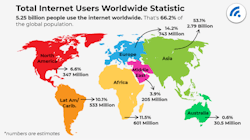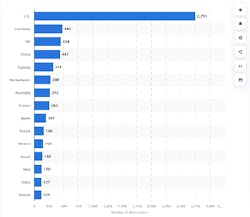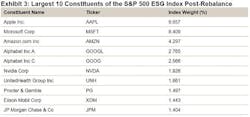ESG – The Unanticipated Roadmap to ROI
By taking a proactive stance on environmental, social and governance issues, businesses can protect their reputation, protect their workers and improve their overall performance.
It’s Rush Hour Traffic on the Information Superhighway
With humanity relying on digital technology more than ever, the pandemic was a global accelerator for cloud adoption. 2022 statistics from Statista estimate usage of the internet increased by 1,355% from 2000 to 2022. 66% of the global population are now using the internet with varying access to connectivity services. Brothers, dads, sisters, and 11-year-old nieces are watching Netflix, streaming scary videos on YouTube, liking photos on Instagram, eating groceries delivered by Instacart, accessing telehealth services, attending school, and talking to friends using Facebook Messenger services.There are more than 6000 data centers in the world. Nearly half are in the United States.
Experts estimate that data centers can use as much as 400 terawatt-hours (TWh) globally, which is about 2% of the worldwide electricity demand, accounting for as much as 3% of global carbon emissions.
And, 33% of the global community has yet to even be introduced to the internet – let alone use it to full potential. (Fun Fact: Since my 92-year old Grandma first got access to the internet a year ago, she has added 2 smart tv’s, an Amazon Show, 2 phones, 2 iPads, and 2 computers to her home located on The Yurok Tribe reservation in rural California. There are some weeks where I Slack messages all the way to datacenter alley from the ‘End of the Road’ via Starlink, a box, and 4 monitors. If you build it, they will come.)
How Does Global Internet Adoption Drive ESG?
I’m so glad you asked! The silver lining of the pandemic was that it sparked demand for digital services that couldn’t be accessed by the homebound global community. And shined a light on all the areas that didn’t have equal access to cat videos, telehealth services, work from home, and online services. And that has led to a boom of innovative connectivity solutions and infrastructure builds on land, sea, and sky.
In 2021, the U.S. alone experienced 20 storms with losses exceeding $1 billion each. In the past 2 years, humanity faced pandemic, economic downturn, unprecedented weather impacts, supply chain disruption, and rising costs of capital, energy, goods and services. Through a window of social media, the global community has witness global social unrest and climate change disasters unfold. Collective voices unite to bring positive societal change to all things ESG. And, when individual consumers put their voices together and unite buying power, the market responds with innovative solutions.
Investors and companies have seen increased regulation, demands for transparency and a quest for standards.
The S&P 500 ESG Index uses environmental, social and governance data to rank and effectively recommend companies to investors. Each year, S&P Global conducts the Corporate Sustainability Assessment (CSA), an ESG analysis of over 11,000 companies. launched to provide ESG-oriented and investable alternatives to leading market benchmarks.
Ninety-two companies added an ESG measure to their 2021 or 2022 annual incentive plans, including 42 that did not previously have an ESG measure. Additionally, 22 companies added an ESG metric to their long-term incentive plans.
In short, if you’re doing business with any of the 11,000 companies on the ESG list, expect procurement to ask about your ESG initiatives. The world is getting small, and customers demand products and services that support inclusion and long-term sustainability.
Now, About That ROI….
Save energy, save the planet, and save costs. Cloud and datacenter energy and water consumption is on the rise. Many cloud services use massive amounts of energy to run, which is why it’s important to be conscientious of your energy consumption. By using cloud services that have lower energy consumption, you’re not only helping the environment but also reducing your carbon footprint. And that’s where strong ROI comes in.
- Servers and cooling systems account for most of the energy usage in data centers. Using ENERGY STAR servers and hardware with ultra-efficient cooling systems maximizes efficiency.
- Edge computing is located closer to customers and helps cut transit and datacenter costs while improving performance and user experience.
- Tailored hybrid and multi-cloud solutions right sized to workload requirements consolidate the number of machines in each customers IT ecosystem, reducing capex spend.
- Efficient cage design paired with organized cable management systems maximize energy efficiency use at the cage level.
- Datacenter and cloud observability with an AI/ML component that introduces predictive analytics in the ecosystem enables an efficient IT ecosystem from sensors to satellites.
- Renewable energy and energy storage use, and carbon offset credits ensure power is sourced as sustainably as possible.
Research shows that diversity increases revenue. Efforts to diversify boards and create policies that foster meaningful diversity, equity, and inclusion will continue to gain adoption. Why? Because we’re building solutions for the global community. Solutions that are built to meet the needs of a diverse planet require representation of the global audience at the table. Whether it’s application, edge, process, compute, storage, building design, automated manufacturing, or subsea cabling, inclusion ensure a more complete solution with less trial and error at scale. And that yields positive ROI.
- In 2020, McKinsey & Company released the Diversity Wins report which showed that diverse companies are more likely to be more profitable.
- Studies have shown that when women are included on corporate boards, there is a greater chance improved investment efficiency, better engagement between board members as well as less fraud cases and operations-based lawsuits.
- Having a diverse range of perspectives in boardrooms can help businesses to think outside the box and make better decisions for their future.
A Journey of One Thousand Miles….
Like the information superhighway that we’re all building, we’re building ESG into the cloud and datacenter industry. What’s great is, the industry if full of people with the pioneer spirit. We’re all part of building something that’s never been built. And, as such, all comfortable with failure and change. So, adoption of ESG is happening quickly. (Fun Fact: Nobody has it all figured out. And when it comes to inclusion, most people just want to be seen for the individual they are and genuinely want to reciprocate but don’t know where to begin the conversation for fear of offending someone. I can’t tell you the number of times I’ve been approached by a male peer saying, “I want to help. I just don’t know where to start and don’t want to upset someone by asking the wrong question or saying something inappropriate.”)
Every organization is different and every organization’s approach to adopting ESG initiatives is in varying stages of development and adoption. Maybe you’re in the assessment stage of finding out where you’re starting from. Maybe your comparing Microsoft Emissions Impact Dashboard with Opus Interactive’s Climate-Positive OpusCloud and Google Carbon Footprint. Maybe you have a daughter and you want to improve your allyship skills to be part of building a future where she has a seat at the table for Internet 5.0. Whoever you are, whatever stage you’re in, ESG is a change in the way we build that supports the global community. Take the leap. Ooh! And if you have questions, ask me!
Shannon Hulbert is CEO of Opus Interactive where she leads strategy and vision. The mission of the organization is to build hybrid and multi-cloud solutions that pave the way for sustainable IT and the next generation of technology builders. Contact them to learn more.









